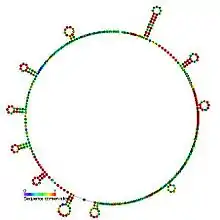CsrB/RsmB RNA family
The CsrB RNA is a non-coding RNA that binds to approximately 9 to 10 dimers of the CsrA protein.[1] The CsrB RNAs contain a conserved motif CAGGXXG that is found in up to 18 copies and has been suggested to bind CsrA. The Csr regulatory system has a strong negative regulatory effect on glycogen biosynthesis, glyconeogenesis and glycogen catabolism and a positive regulatory effect on glycolysis.[2] In other bacteria such as Erwinia carotovora the RsmA protein has been shown to regulate the production of virulence determinants, such extracellular enzymes.[3] RsmA binds to RsmB regulatory RNA which is also a member of this family.
| CsrB/RsmB RNA family | |
|---|---|
 Predicted secondary structure and sequence conservation of CsrB | |
| Identifiers | |
| Symbol | CsrB |
| Rfam | RF00018 |
| Other data | |
| RNA type | Gene; sRNA |
| Domain(s) | Bacteria |
| SO | SO:0000377 |
| PDB structures | PDBe |
RsmB RNA was shown to be upregulated by GacS/A system, and increase downstream T3SS gene expression.[4] FlhDC, the master regulator of flagellar genes, also activates rsmB RNA production.[5] A regulatory network have been revealed connecting rsmB, FlhDC and T3SS.[6]
It has been shown to play role in the biocontrol activity of Rahnella aquatilis HX2 (a biocontrol agent producing antibacterial substance).[7]
References
- Babitzke P, Romeo T (April 2007). "CsrB sRNA family: sequestration of RNA-binding regulatory proteins". Current Opinion in Microbiology. 10 (2): 156–163. doi:10.1016/j.mib.2007.03.007. PMID 17383221.
- Liu MY, Gui G, Wei B, Preston JF, Oakford L, Yüksel U, Giedroc DP, Romeo T (July 1997). "The RNA molecule CsrB binds to the global regulatory protein CsrA and antagonizes its activity in Escherichia coli". The Journal of Biological Chemistry. 272 (28): 17502–17510. doi:10.1074/jbc.272.28.17502. PMID 9211896.
- Cui Y, Chatterjee A, Liu Y, Dumenyo CK, Chatterjee AK (September 1995). "Identification of a global repressor gene, rsmA, of Erwinia carotovora subsp. carotovora that controls extracellular enzymes, N-(3-oxohexanoyl)-L-homoserine lactone, and pathogenicity in soft-rotting Erwinia spp". Journal of Bacteriology. 177 (17): 5108–5115. doi:10.1128/jb.177.17.5108-5115.1995. PMC 177290. PMID 7665490.
- Yang S, Peng Q, Zhang Q, Yi X, Choi CJ, Reedy RM, Charkowski AO, Yang CH (January 2008). "Dynamic regulation of GacA in type III secretion, pectinase gene expression, pellicle formation, and pathogenicity of Dickeya dadantii (Erwinia chrysanthemi 3937)". Molecular Plant-Microbe Interactions. 21 (1): 133–142. doi:10.1094/MPMI-21-1-0133. PMID 18052890.
- Cui Y, Chatterjee A, Yang H, Chatterjee AK (July 2008). "Regulatory network controlling extracellular proteins in Erwinia carotovora subsp. carotovora: FlhDC, the master regulator of flagellar genes, activates rsmB regulatory RNA production by affecting gacA and hexA (lrhA) expression". Journal of Bacteriology. 190 (13): 4610–4623. doi:10.1128/JB.01828-07. PMC 2446818. PMID 18441056.
- Yuan X, Khokhani D, Wu X, Yang F, Biener G, Koestler BJ, Raicu V, He C, Waters CM, Sundin GW, Tian F, Yang CH (November 2015). "Cross-talk between a regulatory small RNA, cyclic-di-GMP signalling and flagellar regulator FlhDC for virulence and bacterial behaviours". Environmental Microbiology. 17 (11): 4745–4763. doi:10.1111/1462-2920.13029. PMC 6652182. PMID 26462993.
- Mei L, Xu S, Lu P, Lin H, Guo Y, Wang Y (2017). "CsrB, a noncoding regulatory RNA, is required for BarA-dependent expression of biocontrol traits in Rahnella aquatilis HX2". PLOS ONE. 12 (11): e0187492. Bibcode:2017PLoSO..1287492M. doi:10.1371/journal.pone.0187492. PMC 5665550. PMID 29091941.